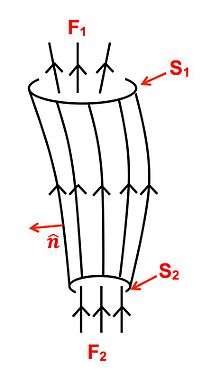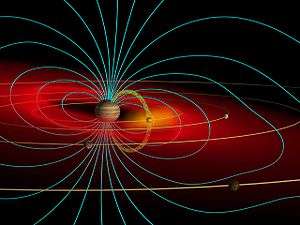Flux tube

A flux tube is a generally tube-like (cylindrical) region of space containing a magnetic field, B, such that the field is perpendicular to the normal vector, . Both the cross-sectional area of the tube and the field contained may vary along the length of the tube, but the magnetic flux is always constant.
As used in astrophysics, a flux tube generally has a larger magnetic field and other properties that differ from the surrounding space. They are commonly found around stars, including the Sun, which has many flux tubes of around 300 km diameter.[1] Sunspots are also associated with larger flux tubes of 2500 km diameter.[1] Some planets also have flux tubes. A well-known example is the flux tube between Jupiter and its moon Io.
Types
History
In 1861, James Clerk Maxwell gave rise to the concept of a flux tube inspired by Michael Faraday's work in electrical and magnetic behavior in his paper titled "On Physical Lines of Force".[2] Maxwell described flux tubes as:
"If upon any surface which cuts the lines of fluid motion we draw a closed curve, and if from every point of this curve we draw lines of motion, these lines of motion will generate a tubular surface which we may call a tube of fluid motion." [3]
Properties
Flux tube strength
The flux tube's strength, F, is defined to be the magnetic flux through a surface, S, with F constant throughout the flux tube as a result of Maxwell's Equation: .[4] Under the condition that the cross-sectional area, A, of the flux tube is small, F can be approximated as .[4] If the area is decreased then the magnetic field must increase in order to satisfy the condition of constant F.[5]
Flux conservation
From the condition of perfect conductivity in ideal Ohm's Law, ( ), in ideal magnetohydrodynamics, the change in magnetic flux, , is zero in a flux tube, known as Alfvén's Theorem of flux conservation. With flux conservation, the topology of the flux tube does not change. This effect arises when there is a high Magnetic Reynolds number, Rm >> 1, where induction dominates and diffusion is neglected, allowing for the magnetic field to follow the flow of the plasma resulting in "frozen-in" flux.[6]
where
- U is the velocity scale of the flow
- L is the length scale of the flow
- η is the viscosity
The rate of change of the magnetic flux is given by:
Compression and extension
In ideal magnetohydrodynamics, if a cylindrical flux tube of length L0 is compressed while the length of tube stays the same, the magnetic field and the density of the tube increase with the same proportionality. If a flux tube with a configuration of a magnetic field of B0 and a plasma density of ρ0 confined to the tube is compressed by a scalar value defined as λ, the new magnetic field and density are given by:[4]
If λ < 1, known as traverse compression, B and ρ increase and are scaled the same while transverse expansion decreases B and ρ by the same value and proportion where B/ρ = constant value.[4]
Extending the length of the flux tube by λ* gives a new length of L = λ*L0 while the density of the tube remains the same, ρ0, which then results in the magnetic field strength increasing by B = λ*B0. Reducing the length of the tubes results in a decrease of the magnetic field's strength.[4]
Plasma pressure
In magnetohydrostatic equilibrium, the following condition is met for the equation of motion of the plasma confined to the flux tube:[4]
where
- p is the plasma pressure
- j is the current density of the plasma
- ρg is the gravitational force
With the magnetohydrostatic equilibrium condition met, a cylindrical flux tube's plasma pressure of p(R) is given by the following relation written in cylindrical coordinates with R as the distance from the axis radially:[4]
The second term in the above equation gives the magnetic pressure force while the third term represents the magnetic tension force.[4] The field line's twist around the axis from one end of the tube of length L to the other end is given by:[4]
Examples
Solar

Examples of solar flux tubes include sunspots and intense magnetic tubes in the photosphere and the field around the solar prominence and coronal loops in the corona.[4]
Sunspots occur when small flux tubes combine into a large flux tube that breaks the surface of the photosphere.[1] The large flux tube of the sunspot has a field intensity of around 3 kG with a diameter of typically 4000 km.[1] There are extreme cases of when the large flux tubes have diameters of km with a field strength of 3 kG.[1] Sunspots can continue to grow as long as there is a constant supply of new flux from small flux tubes on the surface of the sun.[1] The magnetic field within the flux tube can be compressed by decreasing the gas pressure inside and therefore the internal temperature of the tube while maintaining a constant pressure outside.[1]
Intense magnetic tubes are isolated flux tubes that have diameters of 100 to 300 km with an overall field strength of 1 to 2 kG and a flux of around Wb.[4] These flux tubes are concentrated strong magnetic fields that are found between solar granules.[7] The magnetic field causes the plasma pressure in the flux tube to decrease, known as the plasma density depletion region.[7] If there is a significant difference in the temperatures in the flux tube and the surroundings, there is a decrease in plasma pressure as well as a decrease in the plasma density causing some of the magnetic field to escape the plasma.[7]
Plasma that is trapped within magnetic flux tubes that are attached to the photosphere, referred to as footpoints, create a loop-like structure known as a coronal loop.[8] The plasma inside the loop has a higher temperature than the surroundings causing the pressure and density of the plasma to increase.[8] These coronal loops get their characteristic high luminosity and ranges of shapes from the behavior of the magnetic flux tube.[8] These flux tubes confine plasma and are characterized as isolated. The confined magnetic field strength varies from 0.1 to 10 G with diameters ranging from 200 to 300 km.[8][9]
The result of emerging twisted flux tubes from the interior of the sun cause twisted magnetic structures in the corona, which then lead to solar prominences.[10] Solar prominences are modeled using twisted magnetic flux tubes known as flux ropes.[11]
Planetary

Magnetized planets have an area above their ionospheres which traps energetic particles and plasma along magnetic fields, referred to as magnetospheres.[12] The extension of the magnetosphere away from the sun known as a magnetotail is modeled as magnetic flux tubes.[12] Mars and Venus both have strong magnetic fields resulting in flux tubes from the solar wind gathering at high altitudes of the ionosphere on the sun side of the planets and causing the flux tubes to distort along the magnetic field lines creating flux ropes.[12] Particles from the solar wind magnetic field lines can transfer to the magnetic field lines of a planet's magnetosphere through the processes of magnetic reconnection that occurs when a flux tube from the solar wind and a flux tube from the magnetosphere in opposite field directions get close to one another.[12]
Flux tubes that occur from magnetic reconnection forms into a dipole-like configuration around the planet where plasma flow occurs.[12] An example of this case is the flux tube between Jupiter and its moon Io approximately 450 km in diameter at the points closest to Jupiter.[13]
See also
- QCD string, sometimes called a flux tube
- Flux transfer event
- Birkeland current
- Magnetohydrodynamics (MHD)
References
- 1 2 3 4 5 6 7 8 9 Parker, E. N. (1979). "Sunspots and the Physics of Magnetic Flux Tubes. I The General Nature of the Sunspot". The Astrophysical Journal. 230: 905–913. Bibcode:1979ApJ...230..905P. doi:10.1086/157150.
- ↑ Roberts, B (1990). "Waves in Magnetic Flux Tubes". Basic Plasma Processes on the Sun: Proceedings of the 142th Symposium of the International Astronomical Union Held in Bangalore, India, December 1–5, 1989. Edition 1.
- ↑ Maxwell, J. C. (1861). "On Physical Lines of Force". Philosophical Magazine and Journal of Science. 4.
- 1 2 3 4 5 6 7 8 9 10 11 Priest, E. (2014). Magnetohydrodynamics of the Sun. Cambridge University Press. pp. 100–103. ISBN 978-0-521-85471-9.
- ↑ Priest, E. R.; Forbes, T. G. (2001). "Magnetohydrodynamics" (PDF). Nature.
- ↑ Parker, E. N. (1979). Cosmic Magnetic Fields Their Origin and Their Activity. Bristol, UK: Oxford University Press. ISBN 0-19-851290-2.
- 1 2 3 Roberts, B. (2001). "Solar Photospheric Magnetic Flux Tubes: Theory" (PDF). Encyclopedia of Astronomy and Astrophysics.
- 1 2 3 4 Reale, F. (2014). "Coronal Loops: Observations and Modeling of Confined Plasma". Living Reviews in Solar Physics. 11. Bibcode:2014LRSP...11....4R. doi:10.12942/lrsp-2014-4.
- ↑ Peter, H., et. al. (2013). "Structure of Solar Coronal Loops: from Miniature to Large-Scale". Astronomy & Astrophysics. arXiv:1306.4685. Bibcode:2013A&A...556A.104P. doi:10.1051/0004-6361/201321826.
- ↑ Fan, Y. (2015). Solar Prominences. Springer. ISBN 978-3-319-10416-4.
- ↑ Jibben, P.R. et. al. (2016). "Evidence for a Magnetic Flux Rope in Observations of a Solar Prominence-Cavity System". Frontiers in Astronomy and Space Sciences. 3. Bibcode:2016FrASS...3...10J. doi:10.3389/fspas.2016.00010.
- 1 2 3 4 5 Kivelson, M. G.; Bagenal, F. (2007). "Planetary Magnetospheres" (PDF). Encyclopedia of the Solar System.
- ↑ Bhardwaj, A.; Gladstone, G. R.; Zarka, P. (2001). "An Overview of Io Flux Tube Footpoints in Juptier's Auroral Ionosphere". Advances in Space Research. 27. Bibcode:2001AdSpR..27.1915B. doi:10.1016/s0273-1177(01)00280-0.